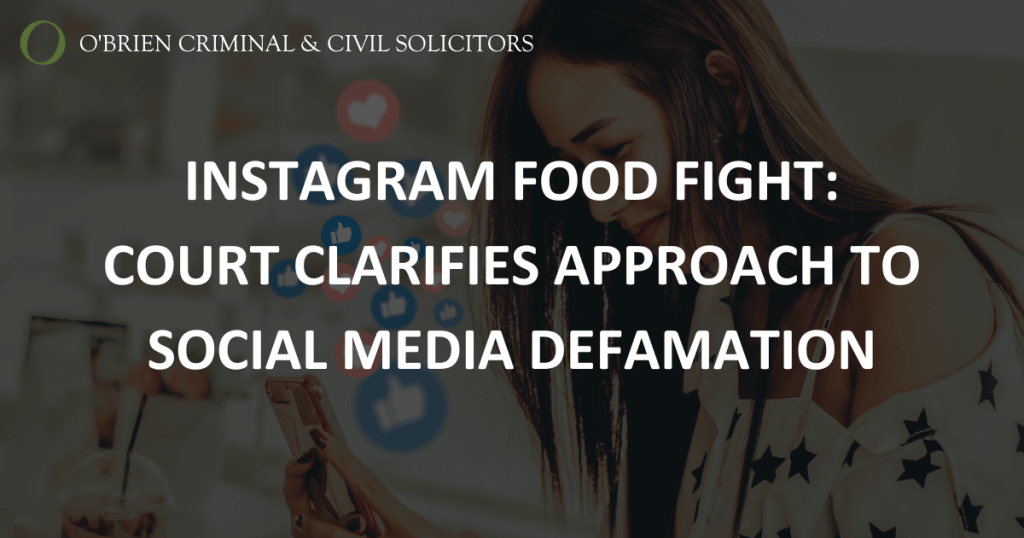In a decision handed down on an Instagram defamation case earlier this week, the District Court set clear guidelines for how the court must address social media defamation.
Last Monday, Her Honour Judge Gibson handed down a decision in relation to defamatory posts made on various Instagram videos.
Importantly, Her Honour addressed some important questions about determining publication, imputations and serious harm.
Click here for specific analysis of serious harm and permanent injunctions.
Food blogger eats words as Court orders him to pay $300,000 damages for Instagram defamation
Issac Martin, who is better known by is handle @issac_eatsalot, was vindicated in the NSW District Court law week. The Court held that two posts by Fouad Najem were held to have been a part of a larger campaign to “attack and discredit the reputation of the plaintiff.”
The Court ordered Najem to pay the rival blogger $300,000 after it held that a series of posts he made stating his rival was a “paedophile” were defamatory.
The defendant did not appear at the hearing nor did he send any legal representatives or produce any evidence.
The ordinary reasonable social media reader: “Dutton v Bazzi is a significant decision”
The “ordinary reasonable reader,” is the one to interpret what the published material really means.
When it comes to social media, that ordinary reasonable reader is not the same as the ordinary reasonable reader of newspapers or a hard-cover biography.
While the Plaintiff referred to cases such as Hockey v Fairfax Media Publications [2015] FCA 652 and Rush v Nationwide News, Her Honour noted that these cases deal with traditional media, not social media.
In fact, Her Honour noted that based on the decision in Bazzi v Dutton [2022] FCAFC 84, applying Hockey v Fairfax Media Publications to social media defamation was no longer good law.
Instead, Her Honour referred to UK case of Stocker v Stocker, which was endorsed by the Full Court in Bazzi v Dutton.
In Stocker at 605–606 [41], Lord Kerr JSC said:
“The fact that this was a Facebook post is critical. The advent of the 21st century has brought with it a new class of reader: the social media user. The judge tasked with deciding how a Facebook post or a tweet on Twitter would be interpreted by a social media user must keep in mind the way in which such postings and tweets are made and read.”
Her Honour concluded that “Dutton v Bazzi is a significant decision, and at appellate level, and is the decision to apply”.
The ordinary reasonable reader and irrational rants
The ordinary reasonable reader, the court submitted, would be wary of irrational rants, distinguishing them from compelling allegations.
As the case was not defended by Najem, Her Honour was careful to take this likelihood into consideration.
“The profanity, aggressive language and at times incoherent presentation used by the defendant is such that some people would have dismissed the defendant’s ranting for such a reason. I suspect that some might have stopped listening to these rants and continued scrolling down to other social media content because the content is so confronting.”
However, Her Honour distilled that the imputations were so profound readers couldn’t miss them.
“[T]he imputations of paedophilia and racism appear at the very beginning of these rants, so even those social media readers who scrolled away would have had difficulty missing them.”
Her Honour referred to the case of French v Fraser where the defendant claimed to take a moral high ground as a consumer advocate.
In that case McCallum J noted that:
“[T]he tone and content of the publications would have prompted some to dismiss Mr Fraser’s missives as irrational rants.”
“Still, the sheer brazenness of the allegations and Mr Fraser’s cynical invocation of the noble status of consumer advocate and activist may have sounded compelling to some readers.”
Quality over quantity when it comes to extent of publication, Court confirms
Her Honour relied on the test set out in Dhir v Saddler [2017] EWHC 3155 (QB) at [55] in relation to the extent of publication on social media.
Dhir set out that it is the “quality of the publications not their quantity that is likely to determine the issues of serious harm in cases involving relatively small-scale publication.”
“What matters is not the extent of publication, but to whom the words are published.” Sloutsker v Romanova [2015] EWHC 545 (QB) stated that it is often said that the graver the imputation, the more likely it is to spread and to cause serious harm.
The Court in Dhir referred to the “sticking power” of the allegations outlined in Slipper v BBC [1991] 1 QB 283, also known as the grapevine effect.
“A feature of the “sticking power” of a defamatory allegation that has potential relevance to the assessment of serious harm is the likelihood of percolation/repetition of the allegation beyond the original publishees (“the grapevine effect”)”
Judge Gibson acknowledged that the posts would not only have been delivered to Najem’s followers, but also to an audience far and wide, through the social media’s algorithms.
“Social media accounts are not just seen by their followers; they may appear on feeds based on AI analysis of likely interested parties, or come up in a search.”
“Paedophile is among the most serious of claims” Court states
Her Honour referred to other cases which involve the most heinous imputation of paedophelia such as French v Fraser.
“Other cases with similar unprovoked attacks alleging paedophilia in social media posts (usually made, curiously, by total strangers) include North Coast Children’s Home Inc. trading as Child & Adolescent Specialist Programs & Accommodation (CASPA) v Martin [2014] NSWDC 125 and Webster v Brewer (No 3) [2020] FCA 1343. “
Her Honour accepted that “while differing amounts have been awarded, all these judgments stress that paedophilia is among the most serious of claims.”
While hurt to feelings is irrelevant to serious harm, it does have weight when awarding damages. “Hurt to the plaintiff’s feelings is of particular importance in this claim. The plaintiff has suffered not only hurt and anxiety, but also from feelings of outrage, humiliation and helplessness at being unable to stop these attacks.”
Aggravated Damages in Instagram Defamation
The posts attracted aggravated damages.
Her Honour referred to certain elements of the claim which supports the award of aggravated damages:
a. The matters, and subsequent videos, demonstrate a malicious campaign against the plaintiff’s business;
b. The attack was incredibly personal, not only insulting Martin professionally but insulted and abusing his wife.
c. Najem’s intention was to encourage others to abuse and troll Martin and put him out of business.
d. The extraordinarily high amount of emotional pain and hurt caused by a campaign of terrifying (because it is meaningless and unexplained) vilification;
e. The whole of Najem’s conduct was improper and unjustifiable;
f. The fact that Najem has not acknowledged any wrongdoing and the judgement in and of itself is likely to induce further attacks.
Her Honour distilled the totality of the damages to $300,000 inclusive of aggravated damages.
If you believe your reputation has been harmed over social media, contact our defamation lawyers today. The first consultation is free.






